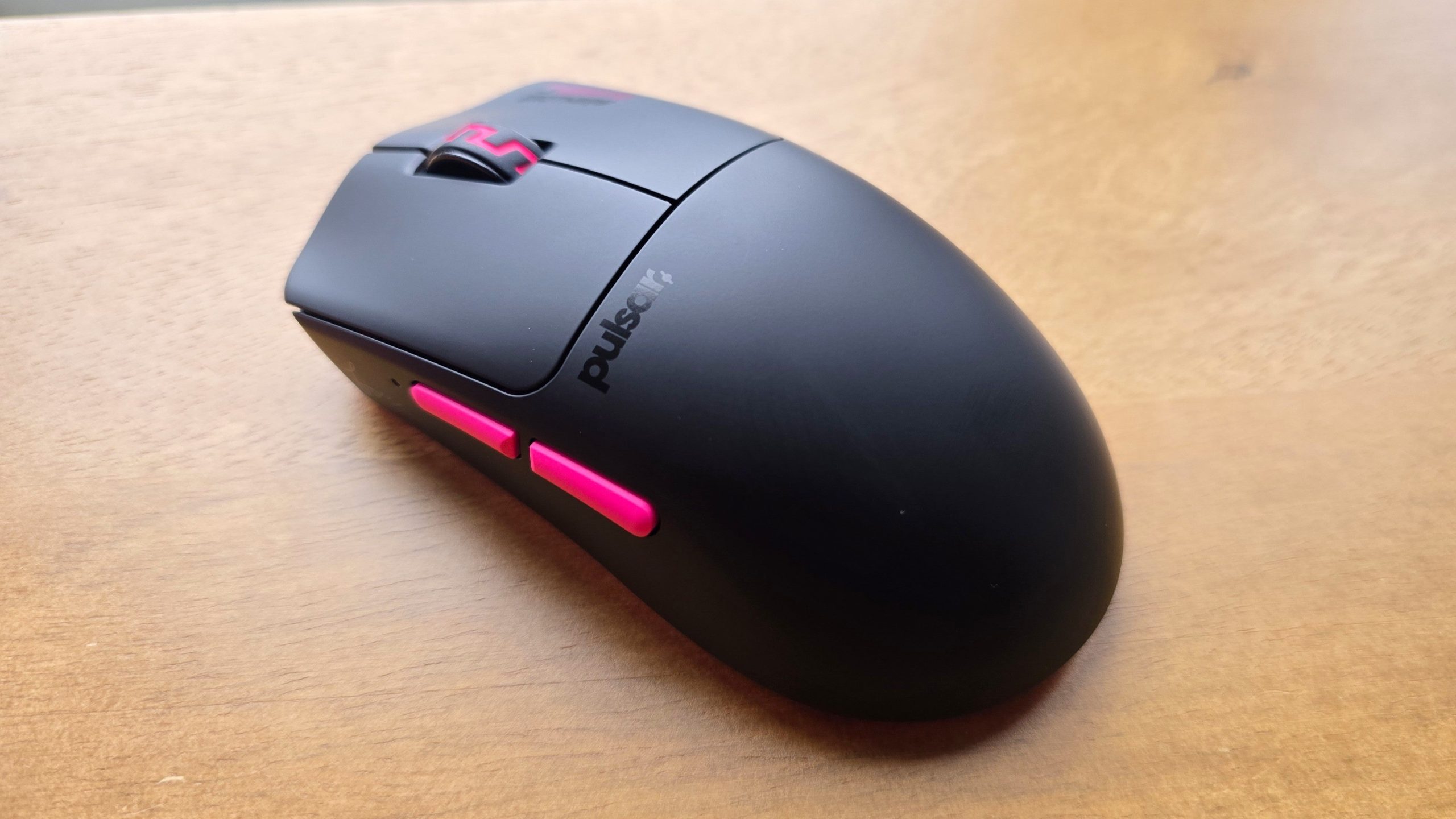
Pulsar Susanto-X Gaming Mouse Review – Hot Pink Design, Fiery Performance
The Susanto-X is part of Pulsar’s Pro series, which collaborates with professional players to design mice. It has the high-end specs you’d expect from a competitive gaming mouse, including an 8000Hz polling rate – and a matching $130 price tag. This lightweight mouse is designed for the Susanto brothers, Valorant pros f0rsakeN and Xccurate, and Pulsar says it’s “meticulously tailored to their individual hand sizes and grip styles.” But will it work for me and you?
Pulsar Susanto-X – PhotosPulsar Susanto-X – Design and ShapeI have to start by mentioning the Susanto-X’s hot pink color scheme. I personally want manufacturers to take big swings on design and for me, the pink accents on the side buttons, the text on the right mouse button, and the zig-zag on the scroll wheel work. It’s distinctive and fun, and keeping black as the base color means it never looks too loud. I don’t follow the Susanto brothers so I could do without their signatures, one on each side of the mouse, but they’re subtle enough to ignore.
The USB dongle and accompanying cable are louder. The dongle is translucent so you can see the outline of its guts, and the packaged cable is pink all the way down. I hated seeing it on my desk at first, but my stance softened over time – the color differentiates it from all the black leads I have plugged in, which is handy when switching devices. And while I wouldn’t be taking this particular mouse on the go, it is a competitive gaming mouse to use at home or tournaments, not for a casual workday at the cafe.
Its distinctive pink accents give it more personality than most high-end mice.
I also like its customizable DPI indicator light, which not every mouse has. The light, next to the side buttons, will change color when you switch DPI, but you can also run it constantly. That’s useful if you switch DPI often between gaming and working or if, like me, you just want an extra pink LED to match the color scheme.
The Sustano-X’s symmetrical shape feels like a crowd-pleaser. It’s not quite as miniature as the HyperX Pulsefire Haste 2 Mini I recently reviewed (currently my favorite compact gaming mouse), but it’s definitely smaller, flatter, and lighter than the average mouse, and it glided effortlessly across my mousepad, requiring very little effort to flick or whip in a wide arc. The wider rear tapers as you move forward, fitting the curve of my fingers, and there are no unusual bumps or grooves to worry about.
If you have larger hands, this is not a mouse for palm gripping: when I tried, I could press all of the buttons but my ring and pinky fingers drooped off the side, hitting my mousemat. I had a similar problem with the Haste 2 Mini, and like that mouse, I could modify my palm grip with the Susanto-X to make it work, but it wasn’t ideal.
Pulsar says this is designed specifically for claw grip. It took me some time to get used to: when I claw grip, my thumb usually slants ever-so-slightly downwards, and the shallow sides of the mouse meant my thumb tip sometimes grazed my mouse pad, which was distracting. I could, however, easily correct it by flattening my thumb and when I got used to it, I found it comfortable for long sessions.
Fingertip grip was equally comfy: the concave left and right mouse buttons kept my fingers in the right place. It helps that the mouse’s smooth coating is incredibly sticky, so you can move it with very little pressure, and there is no chance of it slipping from your grip. The downside is that it attracts fingerprints and grime more than other mice I’ve tested recently, – it’s easy to clean by occasionally wiping it down, and it didn’t bother me, but if your hands are particularly sweaty it’s at least worth keeping in mind.
The mouse buttons are all sturdy and tactile and I liked the crispness and curve of the side buttons in particular. The main left and right clicks, running on optical switches, had some pre-travel – the distance you can press them without registering a click – but that was only noticeable when I was purposefully pushing lightly. During gameplay, they always clicked when I wanted, and I could spam them easily. They sound relatively quiet, but still clean and snappy.
The scroll wheel is less impressive, however. The actual scroll is fine, though I would’ve liked clearer, more defined increments between scrolls, but that’s nitpicking. My main problem is that the wheel shifts left to right with a light push, and it would actually stay off-centre after I pushed it to the right. There are no left and right scroll wheel presses, just the regular central click, but bizarrely, pushing the wheel to the right also registered as a click, but not to the left. None of this seemed to matter for the wheel’s core function, and it scrolled reliably, but it doesn’t fill me with confidence. It is, thankfully, the only misstep in the mouse’s design, and it’s a relatively small one.
Pulsar Susanto-X – Performance, Gaming, and Battery LifeI have zero complaints about how the Susanto-X performed – Pulsar’s XS-1 sensor is fast, responsive and accurate. I tested it in Fortnite for third-person movement, Counter-Strike 2 for precise snaps, and the new puzzle game Strange Antiquities for slower point-and-clicks. It moved exactly as I wanted in every situation; I had no hiccups or stutters, no errors or dropped connections, and I felt confident that my input was being matched precisely on screen.
One of the big selling points of the Susanto-X as a competitive gaming mouse is that its polling rate goes up to 8000Hz: this means the mouse is reporting its position to your computer 8000 times a second, and in theory giving you more responsive, more accurate movement by virtue of tracking at a higher frequency. Most gaming mice are 1000Hz by default, but 8000Hz has slowly become the benchmark for high-end competitive mice.
As I’ve said in other reviews – including for the excellent Razer Deathadder V4 Pro – 1000Hz is fine for most people. To take advantage of higher polling rates you’ll need a high refresh rate monitor of at least 120Hz, but ideally 240Hz or above, and a beefy GPU and CPU to ensure a high in-game frame rate. With those boxes ticked, you might feel a difference as you nudge the polling rate up to 2000Hz or 4000Hz, although perception will come down to the user.
I personally struggle to tell a difference above 1000Hz – but then again, I’m not a professional FPS player. With the Susanto-X, I usually played at 2000Hz, just in case I was getting a benefit I couldn’t definitively calculate. One thing I can say is that with the Deathadder V4 Pro, my frame rate dropped in some games, including Fortnite, when I played at 8000Hz, presumably because it was taxing my CPU. (I didn’t get that with the Susanto-X, although it’s hard to attribute that to the mouse alone because of updates to the game, GPU drivers, and more – just be aware that this could happen.)
Not every gaming mouse gives you 4000Hz or 8000Hz polling rate and if that’s something you need then the Sustanto-X is worth considering. It has a few other tricks that set it apart, namely a toggle for both “motion sync” and “turbo mode.” Motion sync, which Razer mice include by default, matches the timing of your sensor data and your USB polling, giving you a smoother aim that better matches your mouse movements on paper. I didn’t notice a difference with it on – but I also didn’t notice the downsides you sometimes get with motion sync, which would be a slight input delay.
Its size, shape and sensor make it an easy recommendation for competitive gaming.
Pulsar states turbo mode gives you a “consistent 20,000 FPS sensor scanning rate for smoother, more responsive, and precise aiming.” This refers to the way the mouse’s optical sensor scans the surface it’s on, and has nothing to do with polling rate. It usually varies depending on DPI, polling rate and movement speed. Locking it to 20,000 could, theoretically, improve performance, but I noticed no difference other than my battery draining slightly faster. Some dismiss it as a marketing gimmick, and it’s unlikely to be the limiting factor in performance.
While I didn’t experience a tangible benefit from either setting, I can’t begrudge them being there as options. Some users claim motion sync makes their aim smoother, others say turbo mode feels snappier, especially at lower DPIs. Not every manufacturer gives you the flexibility with these kinds of performance-based options, so it at least makes the Susanto-X stand out in a crowded field.
As for battery, Pulsar claims it’ll last 100 hours at 1000Hz polling rate, which was in line with my testing, and solid for a mouse in this price range. You will find longer-lasting mice, such as that Deathadder V4 Pro, but for me 100 hours is more than enough juice for two weeks between charges. The battery life falls noticeably at higher polling rates, dropping to 20 hours at 8000Hz, but that comes with the territory.
Looking to upgrade your keyboard, too?
SteelSeries Apex Pro (Gen 3)
From nearly every angle, the SteelSeries Apex Pro is the ideal gaming keyboard with Hall Effect switches, an OLED control panel, and solid construction.
Be sure to check out our roundup of the best gaming keyboards!
Pulsar Susanto-X – SoftwarePulsar has its own mouse app, but you can also control its mice entirely from a web browser. That’s rare, and a big bonus if you don’t want to clutter your PC with additional software, especially if you use multiple mice. Unfortunately, I found customizing the Susanto-X a bit confusing whether on the standalone app or in a browser.
You can’t run the standalone app fullscreen, which is odd, and the browser-based app wouldn’t run in Chrome with my tab at 100% zoom level (it told me I had to “enlarge the window”). When I zoomed out to 90% it worked – again, it’s odd. Changing the basics was simple enough, such as adjusting DPI step levels and their associated LED color, and remapping buttons and changing the mouse polling rate. But there are too many unexplained options on screen. “Improve pointer precision” can be turned on and off, but there isn’t even at least a tooltip of how it works or whether there are any drawbacks. Turbo mode and motion sync aren’t explained either, which would be confusing for new users.
I’m glad it has a “mouse rotation” tool, which lets you rotate the mouse axis to compensate for any natural left or right tilt in your grip. Few mice offer this, but if I hadn’t used it before, I don’t think the accompanying description would’ve been useful. It reads, “This feature compensates for mouse movement to make movement in a specific direction smoother or to alleviate the phenomenon of mouse movement being skewed due to the angle of the user’s wrist.” Sorry, what?
Contrast this with Razer’s Synapse software, which links out to a specific testing tool for mouse rotation, and recommends a level based on your movements. There are also inexplicable differences between the browser and desktop apps. The rotation calibration is web-only, the “improve pointer precision” is only on the standalone app. They couldn’t agree on what the latest version of the mouse firmware was: when I updated on my desktop, the browser-based software then told me the mouse was out of date. I found the whole thing utterly perplexing.
Originally posted:
Sep 19, 2025 10:16 pm
VerdictConfusing software and an imperfect scroll wheel aren’t enough to put me off the Pulsar Susanto-X. Its size, shape and sensor make it an easy recommendation for competitive gaming, and its distinctive pink accents give it more personality than most high-end mice. Although the benefits of its high 8000Hz polling rate will matter to a select few and under specific conditions, there’s no denying that the Susanto-X is a great high-performance mouse.











